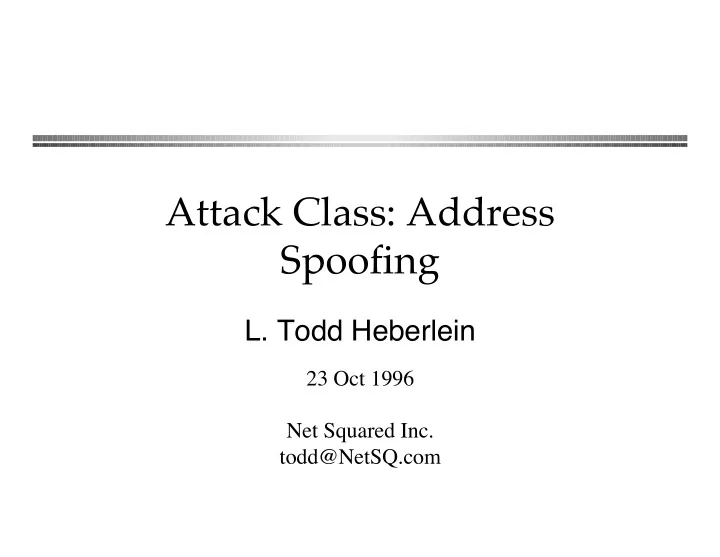

Attack Class: Address Spoofing L. Todd Heberlein 23 Oct 1996 Net Squared Inc. todd@NetSQ.com
Overview of Talk l Introduction l Background material l Attack class l Example attack l Popular questions l Extensions
UCD Vulnerabilities Group l UCDÕs vulnerabilities group studies attacks and their underlying vulnerabilities for the purpose of modeling them. We believe a sufficiently complete model will allow us to both predict new instances of general attack classes and build generic schemes for detecting exploitations of general vulnerability classes.
Address Masquerading l Many of todayÕs network services use host names or addresses for both identification AND authentication. l Examples: rlogin, rsh, mountd, wrappers, firewalls l Higher level services use these lower level services (e.g., backups)
History of Talk l R.T. Morris, 85 l UCD paper, spring 95 l S. Bellovin, 89 l Mendax, Rbone, l UCD Discussed, summer 95 Feb. 94 l Wee (UCD), fall 95 l UCD Presented, Mar 94 l USAF project, Jan. 96 l Mitnick-Tsutomu, Dec 94
Orders and Dialogues l Need better names È asynchronous vs. synchronous È connectionless vs. connection-oriented l An order is a request requiring only a single ÒmessageÓ. l A dialogue is a request which requires the exchange of several, interdependent ÒmessagesÓ. l From recipientÕs point of view
Connectionless Communication (Orders) l Connectionless communication (e.g., supplied by UDP), does not keep state information l No guarantee of delivery or order l Efficient in many environments l RPC on UDP (NFS)
Connection-oriented Communication (Dialogues) l Additional state information kept, representing a limited history of communication l Provides ÒguaranteeÓ that information will both arrive and arrive in order l May require more resources and be less efficient in some environments
TCP/IP Example l Three phases: set- Connection Set-up Host Host up, data exchange, B A tear-down SYN Seq #: X Ack #: 0 l set-up is a three- Time Time SYN, ACK Seq #: Y Ack #: X+1 way handshake ACK Seq #: X+1 Ack #: Y+1 l Third packet requires information Connection Established from second packet.
Routing in an internet A G From: A To: B B E l Host constructs packet and simply places it on the network l As the packet travels across the internet, only the destination address is used
The Attack l Definition of what an attack is l Restrictions to be concerned with l Strategy of the attacker
Definition of Attack l Players: Alice (A), l EveÕs goal: To get Bob (B), and Eve (E) Bob to perform a l Bob grants Alice specific action special privileges by that he would listing AliceÕs perform for Alice address or name in but not Eve a special file l Eve is the villain
Restrictions l The placement of Alice, Bob, and Eve (the topology) l The nature of the communication required by Eve to carry out the attack. l These restrictions will help define EveÕs strategy
Architecture (or Topology) E 4 E 3 E 1 Cloud Cloud 2 1 A E 2 B l Alice and Bob on separate networks; Eve in one of four locations l Other architectures are simply special cases of this one
Nature of Communication l EveÕs communication must be indistinguishable from AliceÕs communication with Bob l Order communication È request is carried out immediately È No role-backs l Dialogue communication È must make sense to Bob È Alice cannot be allowed to interfere
EveÕs Strategy l Establish a forged communication with Bob l Prevent Alice from alerting Bob until it is too late
Establishing a Forged Communication l Construct packet, and place it on the network. The network will deliver it for Eve l For order-based communication, the communication is done l For dialogue-based communication, further messages must be exchanged È if Eve is in E 1 , E 2 , or E 3 , further communication is easy È if Eve is in E 4 , she must either modify the messagesÕ routes, or predict what the messages will contain
Prevent Alice from Interfering l Prevent BobÕs packets from reaching Alice (or AliceÕs from reaching Bob) l Take away AliceÕs ability to respond È wait for Alice to go down for maintenance È force Alice to crash È block part of AliceÕs operating system from processing BobÕs packets (graceful ??) l Complete communication before Alice can respond
Example Attack Players E adversary non-existent A server address E B X-client 2 1 Steps 1 Prevent Alice From 3 Responding 2 Probe for sequence A B number prediction 3 Forge communication l Used against Tsutomu Shimamura, attributed to Kevin Mitnick l Detailed ten years earlier by R.T. Morris
Questions A E l CouldnÕt this attack be stopped by simply configuring Route G routers not to forward obviously Point of Convergence forged packets? G B
Questions cont. l CouldnÕt we require all ÒtrustedÓ hosts to belong to the same physical network and use lower level addresses (e.g., ethernet)? ie(7D) Devices ie(7D) NAME ie - Intel 82586 Ethernet device driver SYNOPSIS /dev/ie DESCRIPTION ... The DL_SET_PHYS_ADDR_REQ primitive changes the 6 octet Eth- ernet address currently associated (attached) to this stream. The credentials of the process which originally
Questions cont. l CouldnÕt we simply write a more secure algorithm for choosing initial sequence numbers? l Only if Eve is NOT is position E 1 , E 2 , or E 3 , and Eve is NOT able to alter the path of BobÕs messages to Alice (e.g., source routing or routing table modification). Also, this solution does not apply to order-based communications.
Extensions to this Attack: Session Hijacking l One-time authentication services are vulnerable l Commercial programs exist which do session hijacking l Demonstrated against systems with challenge-response authentication
Extensions cont. l EveÕs goal: To get Bob to accept information he would only accept from Alice Rlogin Connection A1 NFS-Alice Request A2 Bob DNS-Alice B Reply Forged Reply A3 NIS-Alice
Recommend
More recommend